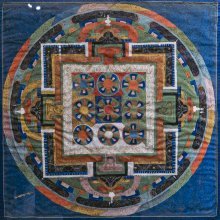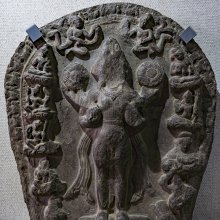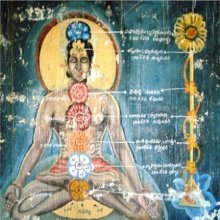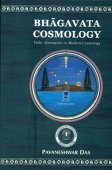Navagraha, Navan-graha, Navagrahā, Nava-graha: 19 definitions
Introduction:
Navagraha means something in Buddhism, Pali, Hinduism, Sanskrit, Jainism, Prakrit, the history of ancient India, Marathi. If you want to know the exact meaning, history, etymology or English translation of this term then check out the descriptions on this page. Add your comment or reference to a book if you want to contribute to this summary article.
Images (photo gallery)
(+10 more images available)
In Hinduism
Natyashastra (theatrics and dramaturgy)
Source: archive.org: The mirror of gesture (abhinaya-darpana)Hands that indicate the Nine Planets (nava-graha):
- Sūrya,
- Candra,
- Aṅgārakha,
- Budha,
- Bṛhaspati,
- Śukra,
- Śanaiscara,
- Rahu,
- Ketu;

Natyashastra (नाट्यशास्त्र, nāṭyaśāstra) refers to both the ancient Indian tradition (shastra) of performing arts, (natya—theatrics, drama, dance, music), as well as the name of a Sanskrit work dealing with these subjects. It also teaches the rules for composing Dramatic plays (nataka), construction and performance of Theater, and Poetic works (kavya).
Shilpashastra (iconography)
Source: Shodhganga: The significance of the mūla-beras (śilpa)Navagraha (नवग्रह) refers to the “nine planetary divinities”, images of which are found scattered within Hindu temples.—T. A. Gopinath Rao points out the specificities of each temple by saying that each temple is filled with numerous images of gods, goddesses, parivāra-devatas (gods related in a family), devas (attendants to the gods), śālagrāmās (cakra–an ammonite shell), bānaliṅgās (egg-shaped pebbles), yantras (mystic and magical diagrams engraved upon metallic plates), navagrahas (the nine planetary divinities), certain divine animals and birds, certain holy rivers, tanks, trees and sepulchers of saints.
The nine planets are:—
- Sūrya (Sun),
- Candra (Moon),
- Aṅgāraka (Mars),
- Budha (Mercury),
- Bṛhaspatī (Jupiter),
- Śukra (Venus),
- Śani or Śanaiścara (Saturn),
- Rāhu (dragon’s head),
- Ketu (dragon’s tail).
Few planets are discussed with respect to the hastas in Bharatanatyam and iconography.

Shilpashastra (शिल्पशास्त्र, śilpaśāstra) represents the ancient Indian science (shastra) of creative arts (shilpa) such as sculpture, iconography and painting. Closely related to Vastushastra (architecture), they often share the same literature.
Jyotisha (astronomy and astrology)
Source: Google Books: Studies in the History of the Exact Sciences (Astronomy)Navagraha (नवग्रह) refers to the “nine planets”, according to the Āśvalāyanagṛhyapariśiṣṭa (2.3).—[Images of and offerings to grahas]—The materials which are used to compose the images (pratimā) of the grahas [i.e., navagraha] are prescribed: red copper (Sun), crystal (Moon), red sandal-wood (Mars), gold (Mercury and Jupiter), silver (Venus), iron (Saturn), lead (Rāhu) and white copper (Ketu) [i.e., kāṃsya]. Such prescriptions for the planetary images are not found in gṛhya texts except in the Āśvalāyanagṛhyapariśiṣṭa (2.3) where the materials [i.e., for the navapratimā] are almost the same as those in Yājñavalkyasmṛti, the only difference being the use of saffron for Mercury instead of gold. According to the Śāntikalpa (13.3), red copper (Sun and Mars), gold (Mercury and Jupiter), silver (Moon and Venus), and black iron (Saturn, Rāhu, and Ketu) are used.
Source: academia.edu: Tessitori Collection I (astronomy)Navagraha (नवग्रह) refers to the “nine planets”, according to the Śanīkathā by Jīvanadāsaka Bhīvāṇī (classified as literature dealing with astronomy, astrology, divination, medicine), which is included in the collection of manuscripts at the ‘Vincenzo Joppi’ library, collected by Luigi Pio Tessitori during his visit to Rajasthan between 1914 and 1919.—Accordingly, “The nine planets (navagraha) quarelled about their relative greatness. They first went to Indra to solve the debate. He did not find any solution and sent them to king Vikramāditya who was to decide who is great or who is small. [...]”.

Jyotisha (ज्योतिष, jyotiṣa or jyotish) refers to ‘astronomy’ or “Vedic astrology” and represents the fifth of the six Vedangas (additional sciences to be studied along with the Vedas). Jyotisha concerns itself with the study and prediction of the movements of celestial bodies, in order to calculate the auspicious time for rituals and ceremonies.
General definition (in Hinduism)
Source: Apam Napat: Indian MythologyIn Indian Astrology, the nine planets are :
- Surya the sun,
- Chandra the moon,
- Budha (Mercury),
- Shukra (Venus),
- Brihaspati (Jupiter) also known as Guru,
- Angaraka (Mars),
- Shani (Saturn),
- Rahu
- and Ketu.
Parvati, in her role as Shakti, is said to the overlord of these planets. According to the Puranas, the planets control all aspects of our lives. Even the Gods themselves are not exempt from their influence.
In Buddhism
Tibetan Buddhism (Vajrayana or tantric Buddhism)
Source: OSU Press: Cakrasamvara SamadhiNavagraha (नवग्रह) refers to category of afflictions [i.e., navagrahāriṣṭa-śānti-kāmanārthaṃ], according to the Guru Mandala Worship (maṇḍalārcana) ritual often performed in combination with the Cakrasaṃvara Samādhi, which refers to the primary pūjā and sādhanā practice of Newah Mahāyāna-Vajrayāna Buddhists in Nepal.

Tibetan Buddhism includes schools such as Nyingma, Kadampa, Kagyu and Gelug. Their primary canon of literature is divided in two broad categories: The Kangyur, which consists of Buddha’s words, and the Tengyur, which includes commentaries from various sources. Esotericism and tantra techniques (vajrayāna) are collected indepently.
In Jainism
General definition (in Jainism)
Source: archive.org: The Jaina IconographyNavagraha (नवग्रह) refers to a group of deities representing the “nine planets”, commonly depicted in Jaina iconography.—The Jainas following the earlier Brahmanic tradition reduced the Planetary system to a group of iconic representations, which constitute an important class of gods known as Jyotiṣka-Devas. [...] In the discoveries of Jaina scriptures, we have had very little instance of meeting with the separate figures of their nine planets (navagraha).

Jainism is an Indian religion of Dharma whose doctrine revolves around harmlessness (ahimsa) towards every living being. The two major branches (Digambara and Svetambara) of Jainism stimulate self-control (or, shramana, ‘self-reliance’) and spiritual development through a path of peace for the soul to progess to the ultimate goal.
India history and geography
Source: archive.org: The Indian Buddhist Iconography (history)Navagraha (नवग्रह) refers to the “nine planets”.—From time immemorial people in India believed in the power of the planets [viz., navagraha] either for evil or for good. That belief is still current. The Hindus, Buddhists and Jainas alike shared in this belief, and in all these three religious systems the planets were deified and they were given a form, weapon and colour.

The history of India traces the identification of countries, villages, towns and other regions of India, as well as mythology, zoology, royal dynasties, rulers, tribes, local festivities and traditions and regional languages. Ancient India enjoyed religious freedom and encourages the path of Dharma, a concept common to Buddhism, Hinduism, and Jainism.
Languages of India and abroad
Marathi-English dictionary
Source: DDSA: The Molesworth Marathi and English Dictionarynavagraha (नवग्रह).—m (S) The nine planets; viz. the sun, moon, mercury, venus, mars, jupiter, saturn, rahu, ketu. 2 Revilingly or irrisively. A term for an association or band of persons; answering to Crew, pack, knot, gang.
Source: DDSA: The Aryabhusan school dictionary, Marathi-Englishnavagraha (नवग्रह).—m The nine planets. A term for an association or band of persons; answering to Crew, pack, knot, gang.
Marathi is an Indo-European language having over 70 million native speakers people in (predominantly) Maharashtra India. Marathi, like many other Indo-Aryan languages, evolved from early forms of Prakrit, which itself is a subset of Sanskrit, one of the most ancient languages of the world.
Sanskrit dictionary
Source: DDSA: The practical Sanskrit-English dictionaryNavagrahā (नवग्रहा).—m. (pl.) the nine planets. (the sun, the moon, 5 planets, rāhu and ketu; see under graha. -gva nine-fold, consisting of nine. -caṇḍikā f. the nine caṇḍikās (śailaputrī, brahmacāriṇī, candraghaṇṭā, kūṣmāṇḍā, skanda- mātā, kātyāyanī, mahāgaurī, kālarātri, siddhidā); Chaṇḍī Pāṭha.
Derivable forms: navagrahāḥ (नवग्रहाः).
Navagrahā is a Sanskrit compound consisting of the terms navan and grahā (ग्रहा).
Source: Cologne Digital Sanskrit Dictionaries: Shabda-Sagara Sanskrit-English DictionaryNavagrahā (नवग्रहा).—m. plu.
(-hāḥ) The nine planets, or sun, moon, five planets, and the ascending and descending nodes. E. nava for navan, and graha a planet.
Source: Cologne Digital Sanskrit Dictionaries: Benfey Sanskrit-English DictionaryNavagraha (नवग्रह).—adj. lately caught, [Rāmāyaṇa] 2, 58, 2.
Navagraha is a Sanskrit compound consisting of the terms nava and graha (ग्रह).
Source: Cologne Digital Sanskrit Dictionaries: Monier-Williams Sanskrit-English Dictionary1) Navagraha (नवग्रह):—[=nava-graha] [from nava] 1. nava-graha mfn. (for 2. See 4. nava) recently caught. Kad.
2) [=nava-graha] [from nava] 2. nava-graha m. [plural] the 9 planets (id est. sun, moon, 5 planets with Rāhu and Ketu), [Horace H. Wilson]
Source: Cologne Digital Sanskrit Dictionaries: Yates Sanskrit-English DictionaryNavagraha (नवग्रह):—[nava-graha] (hāḥ) 1. m. plu. Sun, moon, five planets and the nodes.
[Sanskrit to German]
Sanskrit, also spelled संस्कृतम् (saṃskṛtam), is an ancient language of India commonly seen as the grandmother of the Indo-European language family (even English!). Closely allied with Prakrit and Pali, Sanskrit is more exhaustive in both grammar and terms and has the most extensive collection of literature in the world, greatly surpassing its sister-languages Greek and Latin.
Kannada-English dictionary
Source: Alar: Kannada-English corpusNavagraha (ನವಗ್ರಹ):—[noun] (astrol.) (pl.) the nine planets that supposedly rule the destiny of all beings.
Kannada is a Dravidian language (as opposed to the Indo-European language family) mainly spoken in the southwestern region of India.
Nepali dictionary
Source: unoes: Nepali-English DictionaryNavagraha (नवग्रह):—n. Astron. the 'nine' planets, viz. Sun, Moon, Mercury, Mars, Jupiter, Saturn, Venus, Rahu and Ketu;
Nepali is the primary language of the Nepalese people counting almost 20 million native speakers. The country of Nepal is situated in the Himalaya mountain range to the north of India.
See also (Relevant definitions)
Starts with (+30): Navagrahabalidanaprayoga, Navagrahabijamantra, Navagrahacakra, Navagrahacintamani, Navagrahadana, Navagrahadanacakradi, Navagrahadashalakshana, Navagrahadhidevatasthapana, Navagrahadhipatyahidevatasthapana, Navagrahadhyana, Navagrahadhyanaprakara, Navagrahadurgapuja, Navagrahaganita, Navagrahahoma, Navagrahajapa, Navagrahajapavidhi, Navagrahakarana, Navagrahakavaca, Navagrahamakha, Navagrahamakhashanti.
Ends with: Anavagraha, Vyanjanavagraha.
Full-text (+79): Rahu, Budha, Ketu, Candra, Surya, Shanaishcara, Shukra, Brihaspati, Shani, Navagrahamakha, Navagrahaprayoga, Navagrahaphala, Navagrahavidhana, Navagrahastava, Navagrahastotra, Navagrahaganita, Navagrahaprashna, Navagrahastuti, Navagrahakavaca, Navagrahapaddhati.
Relevant text
Search found 23 books and stories containing Navagraha, Navan-grahā, Navan-graha, Navagrahā, Nava-graha; (plurals include: Navagrahas, grahās, grahas, Navagrahās). You can also click to the full overview containing English textual excerpts. Below are direct links for the most relevant articles:
Musical Compositions of Muthuswami Dikshitar on Planets < [April – June, 1982]
The Temples of Orissa < [October 1955]
The Temples of Orissa < [October 1955]
Jain Remains of Ancient Bengal (by Shubha Majumder)
Tīrthaṅkara Pārśvanātha with Planetary deities and Dikpālas type < [Chapter 6 - Iconographic Study of Jaina Sculptural Remains]
Miniature Tīrthaṅkara and Planatary Deities type of Candraprabha < [Chapter 6 - Iconographic Study of Jaina Sculptural Remains]
Image worship in Jainism < [Chapter 6 - Iconographic Study of Jaina Sculptural Remains]
Abhinaya-darpana (English) (by Ananda Coomaraswamy)
Puranic encyclopaedia (by Vettam Mani)
Temples in and around Madurantakam (by B. Mekala)
Appendix 3: Thiru Aatcheeswarar Temple Layout
Appendix 2: Thiru Venkateswara (Kadapperi) Temple Layout
Atcheeswarar Temple at Acharapakkam < [Chapter 4 - Prominent Temples in Madurantakam Taluk]
Atithi or Guest Reception (study) (by Sarika. P.)
Part 9 - Paddhatis (ceremonial guides) < [Chapter 5 - The Dharmaśāstra Literature]
Related products









